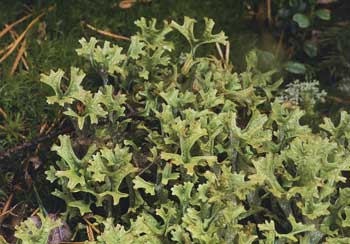Contents:
Common Names | Parts Usually Used | Plant(s) & Culture | Where Found | Medicinal Properties | Biochemical Information
Legends, Myths and Stories | Uses | Formulas or Dosages | Nutrient Content | Warning | Bibliography
Scientific Names

- Cetraria islandica L.
- Parmeliaceae
Common Names
- Chondrus crispus
- Eryngo-leaved liverwort
Parts Usually Used
The herb
Back to Top
Description of Plant(s) and
Culture
Iceland moss is a foliaceous lichen; the thallus, or body of the plant, is branched and erect or spreading, reaching a height of 2-3 inches. It varies in color from olive-green to grayish-white and is sometimes flecked with red.
Back to Top
Where Found
Found in cool, damp places in Europe, Great Britain, Iceland, and the northern parts of North America and Asia.
Back to Top
Medicinal Properties
Anti-emetic, demulcent, expectorant, galactagogue, mucilaginous, nutritive, tonic
Back to Top
Biochemical Information
Mucins (mainly lichenin), bitter fumaric acids, some iodine, cetrarin, uncrystalized sugar, gum, green wax with potash and phosphate of lime, about 70% lichen starch, vitamin A
Back to Top
Legends, Myths and Stories
The English common name “Iceland Moss” is botanically incorrect. This plant is not a moss at all, but a lichen, a symbiosis (mutually beneficial relationship) made up of a fungus and an alga. The name has been used as long as the plant has been in medicinal use; since the 17th century.
Iceland moss is a tough lichen that grows upon the cold stones, and feeds from the damp air. It offers a valuable food for Icelanders and Greenlanders because of its rich starch content. Natives boil the lichen in broth or dry it in cakes and use it as bread. A gruel is made by mixing the lichen with milk. An ounce off Iceland moss boiled for 1/4 hour in a pint of milk or water will yield 7 oz. of thick mucilage. Before using Iceland moss, it is generally soaked in cold water for several hours, after which the water is strained off and thrown away. The lichen may be again dried or used at once as desired.
Iceland moss may be taken in powder, syrup or mixed with chocolate.
Jelly is made as follows: Boil 4 oz. of the lichen in 1 qt. water; then add the juice of 2 lemons and a bit of rind, with 4 oz. of sugar. Boil up and remove the scum from the surface. Strain the jelly through a muslin bag into a basin and set it aside to become cold. It may be eaten this way, but it is better when eaten warm.
Back to Top
Uses
The tea is used for respiratory catarrh, flu, gastroenteritis, dysentery, anemia, and regulation of gastric acid. It serves to stimulate the flow of milk but should not be used if the breasts or nipples are inflamed. Useful for coughs, hoarseness, and bronchitis; used as a blood tonic. Sometimes it is given for tuberculosis, since it acts to dissolve mucous congestion and hinders the growth of the tubercle bacillus. The plant makes a nourishing food, but it must be boiled for a long time to make it palatable.
Back to Top
Formulas or Dosages
Gather in dry weather from May to September.
Decoction: boil 1 tsp. herb in 1/2 cup water for an extended period, adding more water if necessary. Take 1-2 cups per day.
Double tea: add 1 tsp. herb to 1/2 cup cold water and let stand overnight, then warm slightly and strain. Put the soaked herb in cold water and let stand all day; in the evening, bring quickly to a boil and strain. Drink each tea, a mouthful at a time, after it is made. It may be flavored with sugar, lemon peel, honey, or aromatics.
Iceland moss is a bitter with soothing mucilaginous properties. As a mucilage it may be made by covering a handful of the moss with 1 pint to 1 quart of boiling water; let stand 2-3 hours; strain and sweeten with honey or molasses, adding a little lemon juice or a bit of peel. Use freely.
Back to Top
Nutrient Content
Vitamin A
Back to Top
Warning
Use in excessive doses or for prolonged periods can cause gastrointestinal irritation and liver problems. Use for specific symptoms; do not take it for more than 2 weeks at a time.
Back to Top
Bibliography
![]() American Folk Medicine
American Folk Medicine, by Clarence Meyer, Meyerbooks, publisher, PO Box 427, Glenwood, Illinois 60425, 1973
![]() The Complete Medicinal Herbal
The Complete Medicinal Herbal, by Penelope Ody, Dorling Kindersley, Inc, 232 Madison Avenue, New York, NY 10016, First American Edition, copyright 1993
 The Healing Plants
The Healing Plants, by Mannfried Pahlow, Barron’s Educational Series, Inc. 250 Wireless Blvd., Hauppauge, NY 11788, 1992
 Earl Mindell’s Herb Bible
Earl Mindell’s Herb Bible, by Earl Mindell, R.Ph., Ph.D., Simon & Schuster/Fireside, Rockefeller Center 1230 Avenue of the Americas, New York, New York 10020
![]() The Herbalist Almanac
The Herbalist Almanac, by Clarence Meyer, Meyerbooks, publisher, PO Box 427, Glenwood, Illinois 60425, copyright 1988, fifth printing, 1994
![]() The Herb Book
The Herb Book, by John Lust, Bantam Books, 666 Fifth Avenue, New York, NY. copyright 1974.
![]() The Nature Doctor: A Manual of Traditional and Complementary Medicine
The Nature Doctor: A Manual of Traditional and Complementary Medicine, by Dr. H.C.A. Vogel; Keats Publishing, Inc., 27 Pine Street (Box 876) New Canaan, CT. 06840-0876. Copyright Verlag A. Vogel, Teufen (AR) Switzerland 1952, 1991
 Old Ways Rediscovered
Old Ways Rediscovered, by Clarence Meyer, Meyerbooks, publisher, PO Box 427, Glenwood, Illinois 60425, published from 1954, print 1988
![]() Planetary Herbology
Planetary Herbology, by Michael Tierra, C.A., N.D., O.M.D., Lotus Press, PO Box 325, Twin Lakes. WI 53181., Copyright 1988, published 1992
![]() Webster’s New World Dictionary
Webster’s New World Dictionary, Third College Edition, Victoria Neufeldt, Editor in Chief, New World Dictionaries: A Division of Simon & Schuster, Inc., 15 Columbus Circle, New York, NY 10023
